Table of Contents
You probably know what HARO is. You may have even responded to a few of the emails.
But here’s the real question:
Is responding to HARO queries worth your time today?
And if it is, how do maximize your efforts?
In 2008, PR guru Peter Shankman would regularly receive requests from the press looking for sources on everything from professional gardeners to Fortune 100 CTO’s. Peter compiled all of these expert requests, and started sending a daily summary email to his massive subscriber list of PR pros and experts. And thus, Help a Reporter Out, or HARO was born.
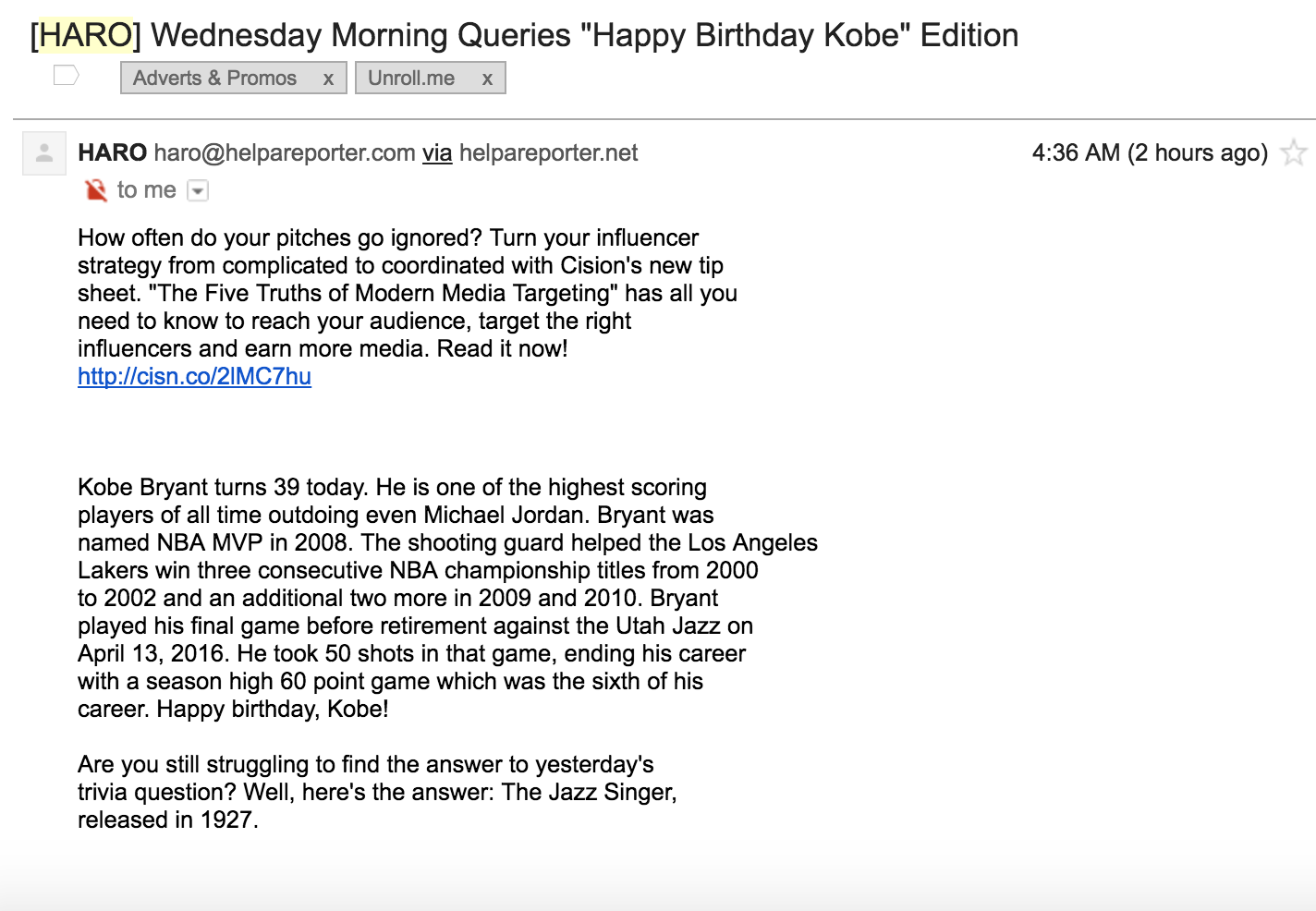
HARO’s list has only grown in subscribers since then. But even with that kind of growth, you can still catch the attention of journalists if you act quickly, and arm yourself with the right knowledge.
In this guide, you’ll get the answers to the following questions (that are also quick links if you want to jump to that section):
- What basics about HARO do I need to know?
- How can I tell if responding to HARO inquiries is worth my time today?
- Subscribing to HARO: Should I use the free version, or go for a paid subscription?
- How can I sort through and manage the flood of HARO requests?
And get:
- 9 Tips for Rocking HARO: Lessons from a writer who’s received 10,500+ Pitches
- Your HARO pitch pre-send checklist
- A game plan for what to do after the pitch
Bonus Material: Get our 21 point checklist for Outreach
HARO Basics: What do I need to know about HARO?
1. HARO emails are sent three times daily at the same times
According to Laura Spaventa, a longtime HARO editor, HARO emails are sent at 5:45 am, 12:45 pm, and 5:45 pm (EST) every day.
However, since the list is so large (HARO had over 100,000 members in 2010), the time you actually receive your email will be staggered either slightly earlier or later.
2. It’s not a quick fix
If your goal is a big traffic and conversion boost in the short term, you’re better off investing elsewhere.
Yes, some businesses have experienced massive success from a HARO placement, like in this instance as told by founder Peter Shankman:
“HARO once helped a bakery stay in business. Was 08/09 during the bad economy – they were close to going out of business – they got a story in a major national daily featuring them – They wound up getting tons of business and weathered the storm.”
However, for the vast majority of businesses that use HARO, this kind of dramatic, life-altering bump isn’t going to happen.
Instead, think of HARO like a slow process. It takes time to refine your pitching skills, get familiar with different journalists, and, if you’re in a very specific niche, wait for a relevant request to crop up.
3. It’s free, but you can pay per month for some extra benefits
HARO works on a freemium model, meaning they have their free service, as well as the ability to pay for a subscription to reap additional benefits. More on this in another couple of sections.
How can I tell if HARO is worth my time?
With so many things you can be doing on any given day to improve your domain authority, is responding to HARO requests really worth the time and effort?
Chad Reir at JotForm did an interesting experiment where him and his team prioritized responding to HARO queries for a whole year, with the end result being (spoiler alert) that they earned 119 mentions from all of their efforts.
However, he goes on to say that a vast majority of these mentions weren’t relevant to their industry, and visitors driven to their website from these mentions were very difficult to convert.
Their experience really drives home some key points you should know when determining whether HARO is right for you:
- Yes, there are a lot of requests, what with three daily emails being sent and all. But most of them won’t be relevant to you.
- If you opt to respond to every query you happen to know about, regardless of relevance to your company or brand, you may get placements, but don’t expect to reap much traffic or many conversions.
- Your best bet is to only respond to queries that are relevant to your company and your target audience, and for which you meet all of the writer’s requirements.
Response time is of the essence
In Peter Shankman’s Growth Hackers AMA, someone asked him what PR strategies are most effective nowadays, since the asker was under the impression that HARO was too big to be useful anymore.
Peter responded with some ideas, then closed with:
“HARO still works, by the way, if you’re super-quick.”
So you’ve heard it from the man himself. Response time is critical to a successful placement. As you’ll hear from Ritika in a later section as she breaks down HARO from the journalist’s perspective, writers often have tight deadlines and quick turnarounds, so the faster you can give them what they want, the better.
What does this all mean for you? For starters, for HARO to be worth your time, you’ll need to be able to check the HARO requests as soon as they get to you, and, if you find a relevant request, be able to put together a response soon after.
If your schedule isn’t very flexible, or you know you won’t be able to set aside time around the email send times, then HARO may not be worth looking into for now.
Look at your goals
When it comes to whether it’s worth your time to sift through HARO requests, it ultimately boils down to this: What is your goal for responding to HARO queries?
If your goal is increasing brand awareness, investing time in HARO could work because as you get placements, your brand name will be seen by a much larger audience. However, increasing brand awareness is a pretty nebulous goal, and difficult to tie to revenue.
If your goal is to supplement your other link building outreach activities, HARO could be worth it too. It’s likely that any journalist who cites you will also throw a backlink your way. And if they don’t, you can always ask nicely once the article is published.
If your goal is to find more journalists to make contact with, this too might make HARO-ing worth it for you. Responding to HARO pitches is similar to doing targeted outreach, except you’re trying to stand out in a sea of competitors in a short time frame. If you can catch their attention in a HARO pitch, then you know you’ve really caught their eye and can start building a solid relationship on that impression.
Now, if your goal was to invest several hours a day in HARO-ing in order to improve your SEO (similar to the JotForm experiment)? Well, I wouldn’t recommend it, and neither would they.
Subscribing to HARO: Should I use the free version, or go for a paid subscription?
We know we have options when it comes to subscribing to the HARO email list. But what do you gain from subscribing to a paid plan?
According to the HARO plans page, benefits range from being able to more easily filter for specific keywords, making the sorting process easier, to getting earlier access to requests than the free audience.
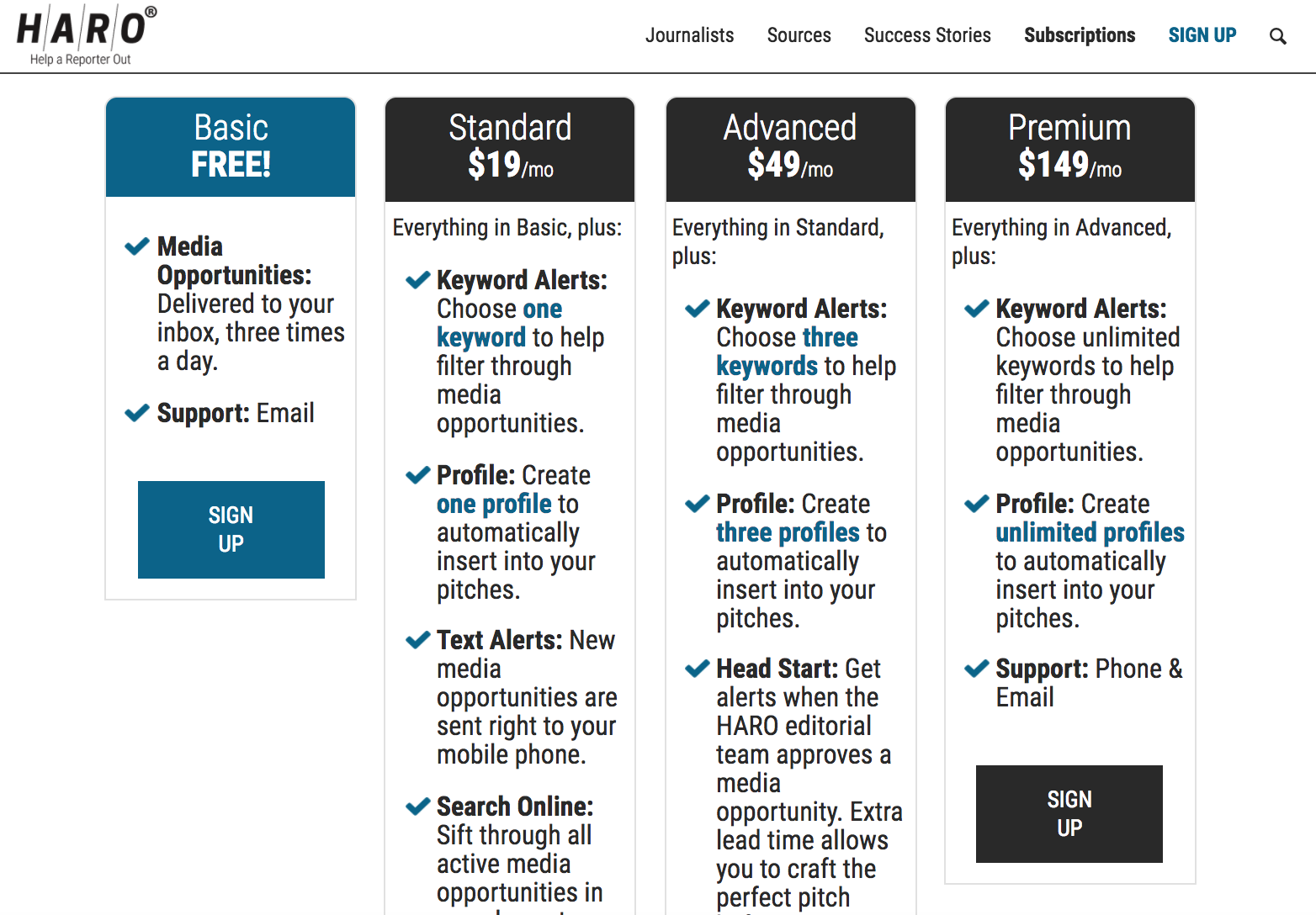
However, you don’t have to look far to see success stories with the HARO free service.
So long as you know when the emails are coming out (and that is around 5:45 am, 12:45 pm, and 5:45 pm Eastern time every day), have a way to quickly filter through the requests, and a template put together for your responses, you probably don’t need to look into the paid options unless you’ve already had proven success with HARO, want to increase it, and are in a very competitive niche.
Note: I haven’t found anyone who’s written in much detail about their experience using a paid HARO subscription, or whether the paid subscription was quantitatively more effective for them in getting placements. (And if so, by how much.) If you have experience with a paid HARO subscription, let us know in the comments below. I’d be super interested to hear you thoughts.
How can I sort through and manage the flood of HARO requests I’m going to get everyday?
Let’s be honest here. You’re going to have to read through a lot of irrelevant HARO posts to find the requests that you can act on.
Unless you have lots of clients in many different niches, monitoring HARO can feel like reading through all of the For Sale ads on Craigslist to find a kayak. (That is, mildly brain-numbing and prone to inducing a general feeling of hopelessness.)
Instead, set up an email filter to catch the relevant queries, and disregard the rest.
How to set up HARO email filters in Gmail
First, go to your Settings by clicking on the gear in the upper right corner, then selecting Settings.
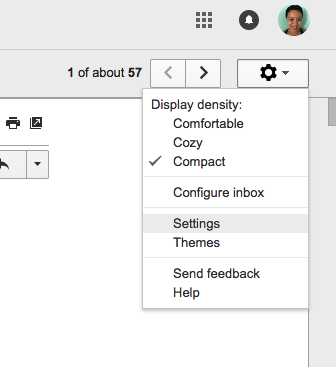
From here, use the top nav bar to click Filters and Blocked Addresses.
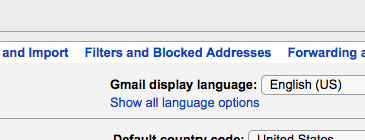
You’ll now see a list of all of the email filters you’ve created. Scroll down to the bottom (which may take a while if you’re like me and ruthlessly sort your emails) and click Create a new filter.

Now it’s time to specify your filter. Fill in the From field with the HARO list email address, haro@helpareporter.com, and add any keywords that are relevant to your company or brand that you think reporters would need an expert in.
If you’re focused on your local footprint, be sure to include your location in your list of desired keywords.
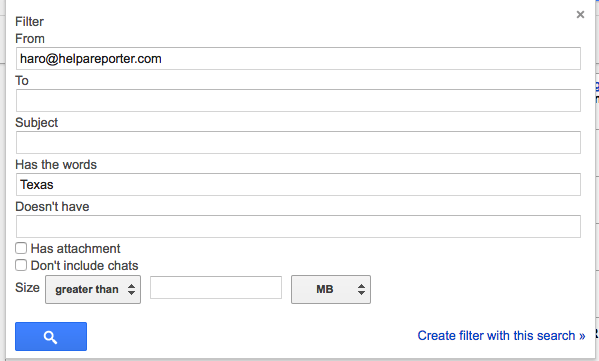
Lastly, see your filter in action and make some final selections.
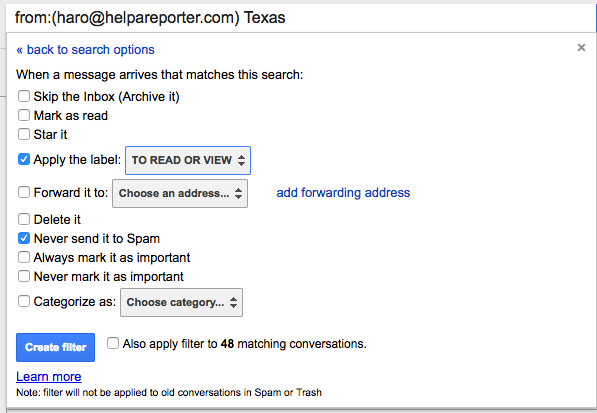
Make sure to select Never send to spam as part of your filter, because HARO emails occasionally do end up there.
When it comes to how or where these emails appear in order to best suit your working style, you can approach this multiple ways.
1. Put them in a label/folder
You can create a HARO label, apply that label to all relevant HARO queries, and have them skip the inbox so it doesn’t set off a notification and clog your normal inbox.
Then, around email query sending times, you can comb through your folder or do a quick search like this:
![]()
The positive side to this approach is that it won’t interrupt your normal workflow. The potential downside is exactly that as well. HARO requests are super time-sensitive, so you don’t want too many hours to pass before you respond. If you’re super-focused on a task at hand, you may forget to check your HARO label and miss an opportunity.
2. Automatically delete any non-relevant HARO emails, and send the rest to your inbox
Another option you can consider is to not send HARO emails to a folder/label, but to create a filter that simply deletes non-relevant emails. Simply fill in your keywords, separated by a | (AKA an “or” function in Regex) in the Doesn’t have field, then in the next window, check the box next to Delete it.
Once you’ve done that, the only HARO emails that will appear in your inbox will be ones that include one of your keywords, so you know there’s something relevant in there.
3. Why not both?
You can always combine the label/folder approach and the auto-delete approach by creating two filters: One that deletes irrelevant HARO emails, and one that sorts any HARO email that gets through into your designated HARO folder, further streamlining your HARO request perusal process.
How to create HARO email filters in other providers
If you don’t use Gmail, fear not! Most email providers today provide some form of email filtering.
For quick reference, here are guides on how to create email filters in:
9 Tips for Rocking HARO: Lessons from a Writer Who’s Received 10,500+ Pitches
The following section was written by Ritika Puri. Ritika is a data-lover and marketer turned entrepreneur and writer who works with content marketers to build lead pipelines, and has written for Forbes, The Next Web, Business Insider, and American Express OPEN Forum.
Help a Reporter Out. From a writer’s perspective, it’s the best of times and the worst of times for the exact same reason—you meet tons of people.
Personally speaking, I’ve met some amazing entrepreneurs, business leaders, PR professionals, and other contacts through the platform. At the same time, I receive dozens of irrelevant pitches per day, and quite candidly, these messages drive me nuts because I have no choice but to ignore them (and that’s a really rude thing to do).
From 2012 to 2015, I was pitched more than 10,500 times. I know this number because I had one of my team members count every single response to every single query that I’ve ever submitted. Out of this batch, there have been a few hundred pitches that have really stood out. They were relevant, on-point, unobtrusive, and truly helpful in speaking to my goals.

In reading roughly 60% of my HARO pitches (I read as many as I can), I’ve recognized the following trend: almost every single person who pitches me is genuinely thoughtful and obviously working hard to make their clients and teams happy. I very rarely see bad apples, and I have immense respect for people seeking coverage: almost everyone has a great story to share.
But when I receive more than 100 responses to a single query, how do I pick the 3 or so people who I choose as interviewees? In answering this question and providing some transparency into my process, my hope is that I can empower you to deliver your best pitch.
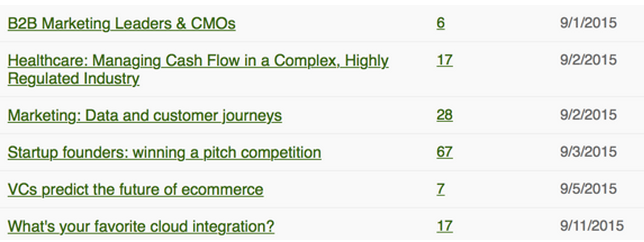
After reading thousands of HARO pitches, here are my best tips:
1. Focus on the story, not the interviewee’s bio
I receive countless HARO pitches with source bios that are 2-4 paragraphs long. I know your interviewee is amazing, but when I’m scanning hundreds of pitches, it’s very easy for me to get lost in the details. Ideally, I’d love to see a one-sentence bio, max—one that allows me to quickly scan the person’s vantage point and experience.
What I love, however, is when PR pros send me a sneak preview into the candidate’s interview: a few sentences, or paragraphs, that clearly demonstrate what the person has to say. This information allows me to decide whether an in-depth interview is worth it: thoughtful, to-the-point comments yield thoughtful, to-the-point interviews.
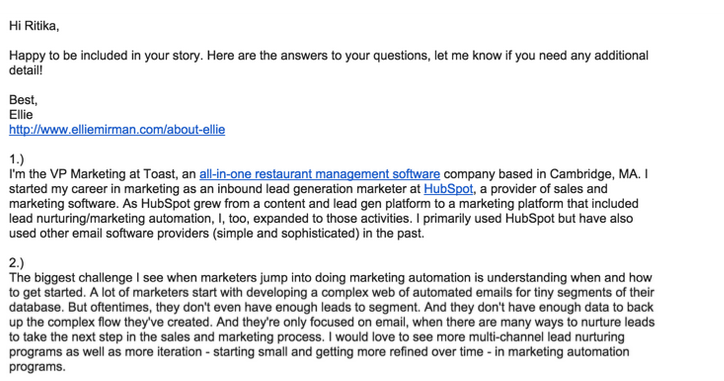
I care about what the interviewee has to say and am less concerned with how many patents the person holds or how many 30 Under 30 awards that he or she has won.
2. Stick to HARO’s system
Like the rest of the world, I’m buried under avalanches of email. I receive hundreds of messages per day and send upwards of 50-80.
Almost daily, someone sends me a really amazing HARO pitch over email, and I end up forgetting about it. Why?
HARO is my tool for keeping query responses organized. I log in when I’m ready to filter through responses, which I usually do in batches. If I receive a direct email—no matter how amazing—I’ll likely ignore it (see amazing pitch example that I accidentally ignored below).

Having heard from thousands of PR professionals, I can empathize with why they’re hunting down my direct contact information. They think that I’m more likely to see and remember something that hits my main inbox.
Receiving so many emails, however, I need a system for organizing PR requests— and it’s not my brain. It’s HARO’s interface.
As an additional sanity check, I also maintain a separate inbox where all of my HARO communication goes. I make sure to read as many of these messages as possible. It’s easier for me to organize than filtering through my main inbox.

Rest assured that your messages are being seen, and I’m less likely to see them when I filter through the details in a systematic way. I’m actually more likely to ignore messages that end up in my main email inbox.
3. Keep your journalist relationships strong
I’m always thrilled when I see a familiar face and PR rep on HARO. There are a dozen or so amazing publicists with whom I’m in touch, and I can honestly say that I wish this list was longer. I’ve met many in person and some have even, out of the blue, referred me to clients.
I love getting to know PR pros because I know that I can ping them when I’m in a pinch. I also love when PR pros get to know me because they consistently share stories from relevant clients. It’s a beautiful, symbiotic thing.
The takeaway here? In your HARO pitches, mention whether you’ve worked with a journalist on a story before. This simple action will jog your recipient’s memory and kickstart a conversation. Show that you’re paying attention. We’re listening, and good journalists appreciate the thoughtfulness.
4. Answer the question in a direct way
I receive many one-liners asking whether I’d like to talk with a particular interviewee.
The short answer? I don’t know, because these pitches fail to provide enough detail for me to make a decision. I end up ignoring these threads as a result.
In all of my HARO queries, I include a specific question or set of questions that I’d like answered. The best responses I get are ones that answer these prompts directly. That way, I can make a quick, in-the-moment decision about whether to follow up. All of the information that I need is right in front of me, and I can send a quick, focused, and constructive email reply.
The end result is a great process on both sides, from start to finish. From the get go, no details are left to the imagination.
5. Keep the process low-touch
Many PR pros who pitch me will assume that I want to hop on a 30-minute call. Running a business, I’m on 5-9 hours of calls oneasy day, and I do not want to schedule more calls. In some situations there are extenuating circumstances: the topic is confusing, or my interviewee needs the guidance of a live q&a—that’s totally fine.
What’s less okay is when a PR pro schedules me for a 6AM call, when his or her contact would prefer to send an email anyway.
I try to keep the process low-touch and clear by specifying the type of interview that I’d like in my HARO query. Many other writers do the same, so please try to pay attention. I always love when PR pros ask if I’d prefer email or phone-based responses. As often as possible I’ll opt for email, and the end result will be outstanding.
6. Don’t ask when a piece will be published
I don’t say this out of annoyance. I say this out of wanting to save you time.
I, like many other freelance writers and content producers, write for dozens of publications. Because I’m independent, I have limited insight into these companies’ editorial schedules. It’s just easier that way—editors are great at what they do and don’t need multitudes of writers as additional cooks in their kitchens. Plus, writers have enough on their minds and can’t humanly track the many moving parts of publishing a piece of content.
It’s worth saying that out of all my tips in this blog post, this one is probably the most controversial. After all, PR reps, clients, and interviewees are thoughtful enough to offer up their time. Not to mention, some writers are editors who are managing their own editorial calendars. The best answer I have is to feel it out. Don’t take a nonresponse as a sign of disrespect, and be content with “I don’t know” as an answer.
Be patient, and you’ll see the story run. And if you’re a PR rep, be transparent about this process with your client, too. Present a realistic view of this process, and your stakeholders will understand.
7. Be personable and helpful
When working on a blog post “How to Overcome Fear of Risk” for Entrepreneur Magazine, I was floored to have received nearly 200 pitches in just 2 days.

As much as I wanted to read and include every single story submission, I couldn’t. After skimming through all 200 pitches, I realized that only 5 were worth the follow-up. The reason boiled down to a few common mistakes:
- The majority of pitches that I received were too promotional and pretentious. Many “talked up” the experiences of the to-be interviewees but failed to provide substantive details that were relevant to the story.
- Many of the pitches asked “if I’d like to see more information.” At the time, I had a 48-hour turnaround, which minimized my available bandwidth for back/forth communication. I needed details off the bat—follow-up communication would have slowed me down.
I realized that there were a few things that would have improved the majority of these pitches. Here’s a quick list that I would have liked for all of these to have:
- A friendly introduction
- A fun fact
- Humility
- Keywords or bullet points that describe the story
The bottom line? It’s possible to make more of an impact by writing less.
8. Make source attribution easy
One of my biggest time sinks as a writer is sourcing. I go through painstaking lengths to research my interview subjects and make sure that I’m referencing them correctly. It’s often a challenge to aggregate information from different sources, so I am more likely to respond to pitches that provide the basics from the start.
Thinking of sending journalists a quote? Make sure to include:
- Who said it
- What that person’s website is
- Their job title
- Their company
- Their social media links
- A link to a press kit
- A Link to a high-res headshot
One tip: HARO doesn’t have the most robust user interface for sorting and categorizing messages, so it’s easy for communication to fall through the cracks under tight deadlines. The content world is chaotic. Make a simple email signature, so writers can find the sourcing details that they need, in one place.
Here’s an example of one of the best HARO pitches that I received for this story:
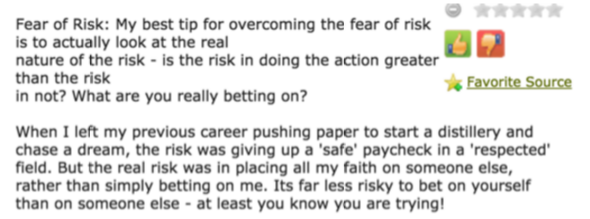 In addition to sharing a great story, the pitch included the person’s name, company details, email address, and social profiles.
In addition to sharing a great story, the pitch included the person’s name, company details, email address, and social profiles.
9. Don’t assume the writer doesn’t like you
It can be demoralizing when you spend hours writing thoughtful emails, and nobody responds. Don’t take it personally; the majority of writers are too slammed for their own good and juggling far-too-many conversations. Our email inboxes look like this:
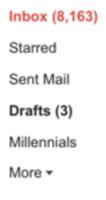
For context, this is my HARO-dedicated inbox.
Be persistent. If you see someone you’re trying to reach at an event or conference, walk up and say hi. There’s no need to take us to lunch, leave us voicemails, or try to fight for our attention. Instead, focus on building an authentic relationship. Remember: Our careers are going to last our entire lifetimes; expect paths to cross, over and over.
Your HARO pitch pre-send checklist
Now that you know how to use HARO and have crafted your beautiful pitch (hopefully using Ritika’s advice above), and it’s time to hit send.
But wait!
The devil is in the details, and you only have one shot at capturing a journalist’s attention. Even a minor mess-up will send a reporter straight into the arms of any of the hundreds of other responses they received in addition to your own.
So before you hit send, run through this list of questions to make sure your pitch is pitch-perfect. (Pun intended?)
- Do you meet all of the journalist’s background and credential requirements? If not, it’s not worth your time or the journalist’s time for you to pitch them. Stop the process right here, tuck your pitch away, and wait for a request that has requirements you can meet. Otherwise, you risk the writer associating your name with the irritation they feel when they open a pitch, read it, and realize it doesn’t meet their standards.
- Did you open with a greeting? It’s more polite than jumping right into answering their questions.
- If you have the reporter’s first name, did you address them by it in said greeting? That will help your email feel more personal.
- Did you answer the exact question asked and follow all of the journalist’s instructions? A word count limit would be an example of an instruction.
- Is your subject line clearly tied to their query? Writers could easily have multiple HARO requests going at the same time, so make it clear which one you’re offering help with.
- Is your subject line attention-grabbing? If you’re not sure, feel free to reference Neil Patel’s guide on headline writing.
- Did you include your source’s name? “Source” here being the person you’re quoting. Could very well be yourself.
- Did you include your source’s job title?
- Did you include your source’s website and company name?
- Did you include links to your source’s social media profiles?
- Did you include a link to your source’s online bio?
- Did you include a link to a Dropbox folder with high-res headshots of your source?
- Did you include at least three to four ways the writer can reach you? Email, phone, Skype, etc. Definitely include phone in case it’s more convenient for them to call.
- Are you sending your response within 12 hours of when the HARO email was sent? If not, consider saving your pitch for another journalist another time, or using that expert quote on your own platform. It’s likely too late to reach the journalist.
- Is your response as short as you can make it? Too long and you risk looking too self-involved and losing the journalist’s attention. Remember: It’s their story; you’re just a small part of it.
- Did you edit for grammar and spelling? Basic errors like these will immediately take you out of the running, so don’t let your hard work go to waste.
- Did you make your pitch skimmable? That is, did you use line breaks and bullet points to break up content chunks? Again, writers = short on time. Make things easy for them.
- Is your pitch 100% on topic? If you notice a tangent or wonder if a section could be seen as irrelevant, cut it.
Want more expert advice on pitching? Check out 17 PR professionals’ best pitching tips.
What to do after the pitch
You’ve sent your beautiful pitch on its way. Now what?
Here are six things to do after you’ve pitched to a HARO request:
1. Don’t follow up
I know we already covered this, but seriously. Don’t do it.
At most, you can send them a tweet right after you send your pitch, but after that, never speak of this again. (Unless they want to, in which case, give the people what they want!)
2. Watch out for your mention
If you haven’t already, create a Google Alert for your name or company name, so you can be notified if you receive a placement.
If you get a backlink as well and happen to use a tool like BuzzStream, BuzzStream’s Link Monitoring tab and relationship stages will let you know.
3. (If you get a placement) Share like you’ve never shared before
Everyone likes getting some recognition, journalists included. Share their article on social (both your company and your personal accounts) and anywhere else relevant, like a thread on an industry forum.
4. (If you get a placement) Say thank you, and let them know you’d be happy to do it again
Once you do get a placement, congrats! Pat yourself on the back, pop some bubbly (Sparkling water, anyone?), and write the journalist a quick thank you note to keep the relationship strong.
In your thank you, mention that you’ve shared the article (and all of the places you’ve shared it), and that you’d be more than happy to be a source for them again.
If they happen to be writing another piece in a similar industry, they might just shoot you the request directly and kill two birds with one stone.
5. Keep up the relationship (with relevant journalists)
Like we covered earlier, don’t let your relationships with journalists you’ve worked with fade into distant memory.
If you have a good idea of what this journalist writes about, or what they’re interested in, send them the occasional news or best practices article that you think would make their job easier. That way, you’ll build a real relationship with this journalist, and they’ll be more likely to think of you when they write their next story, or at least recognize your name in the pile of pitches.
If you don’t think you’ll remember to reach back out to your journalist contacts, try setting some calendar reminders with their bio and beat in the description of the event. On the days your reminders pop up, set aside some time to look around for articles that might interest them, then pass them along.
Note: I would recommend only putting forth this level of effort for journalists whose beat is relevant to your company. Like we learned from the Jotform example, it’s possible to get placements in less-than-relevant contexts and publications, consider it a success, but then drive only meager traffic to your website and convert little to none of it.
6. Track everything
If you have a CRM like BuzzStream, this step is pretty easy. Simply make a project for HARO journalists, forward relevant emails to your BuzzBox address, and track your mentions and backlinks.
You’ll then have all of your conversations with all of the different writers and publications in one place, as well as a way to easily report on the success of your HARO efforts.
If you send your emails from BuzzStream as well, you can even see if your pitch was opened at all, giving you insight into the effectiveness of your subject lines.
If you don’t have a CRM, you can always use a spreadsheet or Google sheet. I’d recommend including columns like:
- Name of publication (with link to website)
- Query name (What it was called in the HARO email)
- Name of reporter
- Link to reporter’s bio page
- Submitted a response? (Yes/No)
- When did I send my response? (Within 1 hour of receiving the HARO email, within the first 2 hours, within the first 3 hours, etc.)
- Your pitch subject line
- Date pitch sent
- Published? (Yes/No)
- Link to published article
Once you have your spreadsheet ready and start filling in data from your HARO pitches, you’ll be able to slice and dice your data for trends, and make your pitches even more effective.
Conclusion
HARO can be a good way to supplement your link building efforts, but only if you are willing to hone your pitching skills and editing skills, and have the ability to respond in a timely manner. If you choose to experiment with HARO, make sure you track your pitches so you’ll be able to look back and make sure it’s effort well-spent.
At its root, HARO is all about making a connection with someone else, and hopefully providing them something that will make their lives easier. In the spirit of helping a reporter out, don’t forget to forward queries along to colleagues who might be a perfect fit to contribute, even if you or your company are not. It never hurts to pay it forward.

 End-to-end outreach workflow
End-to-end outreach workflow



 Check out the BuzzStream Podcast
Check out the BuzzStream Podcast








2 comments
HARO is the great way of getting high quality backlinks and press mentions. By using HARO technique we can get killer authority backlinks from news sites such Huffpost, Nytimes, etc.
But best content is needed for getting our website listed on top news sites otherwise they will reject it.
I am doing HARO for some of my websites and getting awesome results 🙂
Gracelyn Tan Lad, you wrote good article about HARO and some lines are new to me.
Thanks for the awesome post.
Thanks for checking it out, Abdullah! I hope it was helpful!